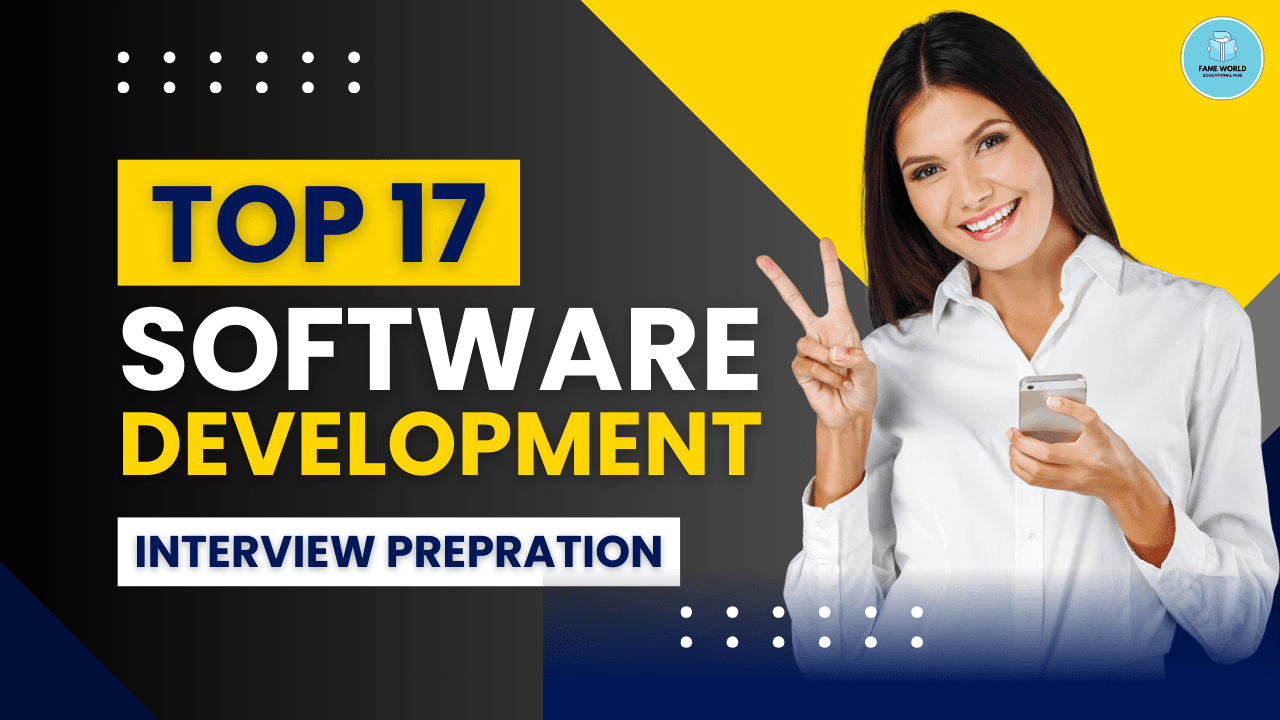Are you preparing for a software development interview? Whether you’re a beginner or an experienced developer, technical interviews can be challenging. To help you ace your interview, we’ve compiled 17 of the most commonly asked questions, along with expert answers.
👉 Don’t forget to watch the video below for more important questions and go through the additional learning material attached at the end!
1. What are the four pillars of Object-Oriented Programming (OOP)?
Answer: The four pillars of OOP are:
- Encapsulation – Restricting direct access to object data and using methods to modify it.
- Abstraction – Hiding complex implementation details and exposing only necessary functionalities.
- Inheritance – Allowing one class to inherit the properties and behaviors of another.
- Polymorphism – Enabling objects to be treated as instances of their parent class.
2. What is the difference between a stack and a queue?
Answer:
- Stack follows LIFO (Last In, First Out) principle (e.g., call stack).
- Queue follows FIFO (First In, First Out) principle (e.g., task scheduling).
3. What is the difference between an abstract class and an interface?
Answer:
- An abstract class can have both abstract methods (without implementation) and concrete methods (with implementation).
- An interface can only have method signatures (in Java before Java 8).
- A class can inherit only one abstract class but can implement multiple interfaces.
4. Explain the concept of a database transaction.
Answer: A database transaction is a sequence of operations performed as a single logical unit of work. It follows ACID properties:
- Atomicity – Transactions are all or nothing.
- Consistency – Transactions bring the database from one valid state to another.
- Isolation – Transactions execute independently.
- Durability – Transactions remain in effect after a crash.
5. What are SQL Joins?
Answer: SQL Joins combine rows from two or more tables based on a related column. Types include:
- INNER JOIN – Returns matching records.
- LEFT JOIN – Returns all records from the left table and matched records from the right table.
- RIGHT JOIN – Returns all records from the right table and matched records from the left table.
- FULL JOIN – Returns all records from both tables.
6. What is a RESTful API?
Answer: A RESTful API follows REST (Representational State Transfer) principles, using HTTP methods such as:
- GET – Retrieve data
- POST – Create data
- PUT – Update data
- DELETE – Remove data It is stateless, scalable, and uses JSON or XML for communication.
7. Explain the difference between synchronous and asynchronous programming.
Answer:
- Synchronous programming executes tasks sequentially, blocking execution until one completes.
- Asynchronous programming allows tasks to run concurrently, improving efficiency (e.g., JavaScript’s async/await).
8. What is a memory leak, and how do you prevent it?
Answer: A memory leak occurs when a program fails to release unused memory. Prevention techniques include:
- Using smart pointers in C++
- Avoiding global variables in JavaScript
- Closing resources like file streams
9. What is the difference between HTTP and HTTPS?
Answer:
- HTTP (HyperText Transfer Protocol) transmits data in plain text.
- HTTPS (HTTP Secure) encrypts data using SSL/TLS, ensuring secure communication.
10. Explain Docker and its benefits.
Answer: Docker is a containerization platform that allows developers to package applications with dependencies. Benefits include:
- Portability
- Scalability
- Faster deployment
- Isolation
11. What is the purpose of Git, and how does it work?
Answer: Git is a version control system that tracks code changes. Key operations:
- git clone – Copies a repository
- git commit – Saves changes
- git push – Uploads changes to a remote repository
- git pull – Fetches updates
12. What are microservices?
Answer: Microservices architecture breaks applications into small, independent services, each handling a specific function. Benefits include:
- Scalability
- Faster deployment
- Better fault isolation
13. What is the difference between Unit Testing and Integration Testing?
Answer:
- Unit Testing tests individual components.
- Integration Testing tests how multiple components interact.
14. What are WebSockets, and when should you use them?
Answer: WebSockets enable real-time communication between a client and server. Use them for:
- Chat applications
- Live notification
- Multiplayer games
15. What is a race condition, and how do you prevent it?
Answer: A race condition occurs when multiple processes access shared data concurrently, leading to unexpected results. Prevention includes:
- Using locks
- Synchronization mechanisms
- Atomic operations
16. What is the difference between NoSQL and SQL databases?
Answer:
- SQL databases (e.g., MySQL, PostgreSQL) use structured tables and schemas.
- NoSQL databases (e.g., MongoDB, Redis) use flexible, non-relational structures like documents and key-value pairs.
17. What is the difference between Monolithic and Microservices Architecture?
Answer:
- Monolithic applications are a single unit, making scaling harder.
- Microservices break applications into smaller services, improving scalability and maintainability.
📺 Watch the Video Below for More Important Questions!
📂
Good luck with your interview! 🚀
Additional learning resources:
PYTHON Q&A SERIES – Link
IOT TUTORIAL SERIES – Link
PYTHON PROGRAMMING TUTORIAL SERIES – Link
CAREER TIPS – Link
CLOUD COMPUTING – Link
MERN FULL STACK WEB DEVELOPMENT – Link
DJANGO SERIES – Link
DIGITAL MARKETING – Link
C LANGUAGE – Link
CODING INTERVIEW PREPARATION – Link
NEW AI TOOLS – Link
PYTHONISTA FOR PYTHON LOVERS – Link
ARTIFICIAL INTELLIGENCE – Link
MACHINE LEARNING USING PYTHON – Link
DBMS – Link
PYTHON PROGRAMMING QUIZ SERIES – Link
BLOCKCHAIN TECHNOLOGY TUTORIAL SERIES – Link
NETWORKING QUIZ SERIES – Link
CYBER SECURITY Q&A SERIES – Link
PROGRAMMING RELATED STUFF – Link
Interview Preparation Series –
DATA ANALYTICS – link
JAVA PROGRAMMING – link
PYTHON PROGRAMMING (BYTE SIZED) – link
PYTHON PROGRAMMING – link
CODING INTERVIEW – link
JAVASCRIPT – link
NETWORKING QUIZ – link
SOFTWARE DEVELOPMENT – link



